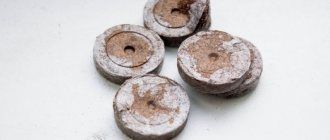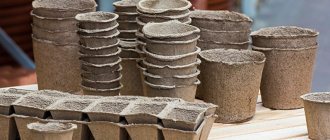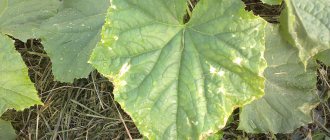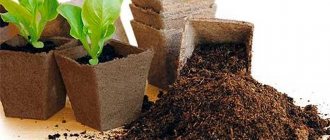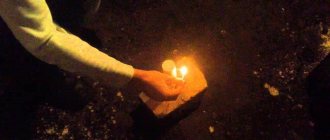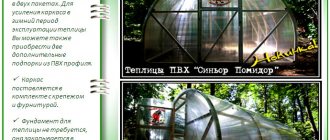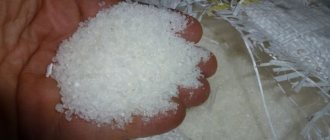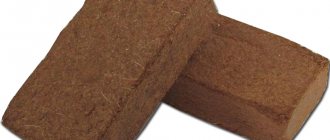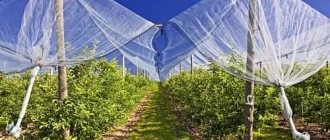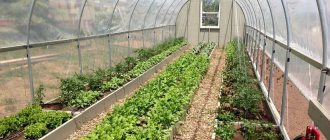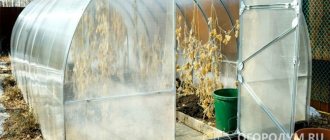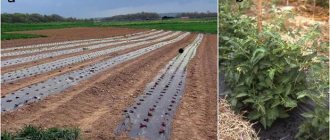It so happened that families of gardeners and gardeners prepare containers for seedlings during the winter. Containers of various sizes and strengths are used: yogurt cups, juice and dairy boxes, homemade paper or cardboard bags. Plastic trays from semi-finished products are not thrown away either - you can sow in bulk on them.
Peat tablets for seedlings - how to use
What are peat tablets?
They were invented for growing seedlings and rooting cuttings. At its core, it is pressed peat placed in special bags made of non-woven material. The composition of peat tablets also includes humus and nutrients necessary for young plants, growth stimulants, and antibacterial components. Therefore, these tablets are also called peat humus tablets. Plants in such “containers” do not need feeding.
Peat has good air and moisture permeability. Namely, it is in such conditions that young plants develop best, and they develop a developed root system. In addition, the composition retains moisture well, but does not allow plants to “catch” a fungal disease.
A mesh with small cells helps the tablet keep its shape, but, at the same time, does not tear when the “filling” increases in size. The diameter of the tablets varies from 24 to 90 mm, and the height – from 8 to 30 mm. The acidity of peat in tablets is usually at a level suitable for growing most garden crops: pH = 5.4-6.2.
How to use seedling tablets
Peat tablets are convenient and easy to use. Even a novice gardener can use them.
Before planting, peat discs must be prepared. They are laid out on the surface of the container with the indentation facing up and filled with warm water. Within 15-20 minutes, the tablets begin to swell, increasing in size.
After the washers become 5-6 times larger than the original volume, the remaining water is drained and sowing begins. Place 1-2 seeds in the recess of the washer. The container is covered with film or a transparent lid. It is necessary to regularly monitor the soil moisture to prevent it from drying out.
The container with seedlings is placed in a warm and sunny place. If the container is placed on a windowsill, then you should take care to protect the plants from cold air.
To do this, a layer of heat-insulating material is placed under the container. Containers should not be placed near heating devices. Dry air will cause the peat substrate to dry out.
Seedlings in peat tablets must be regularly ventilated. As a rule, this is done simultaneously with watering. The key to success when germinating seeds in washers is maintaining an optimal level of humidity.
Before the seeds germinate, watering is best done by drip method. You can also spray the washers with warm water from a spray bottle. It must be set to spray water suspension mode. Irrigation is carried out from a distance of at least 15 cm, to avoid excessive water pressure and washing out seeds from the soil.
When the first shoots appear, watering is done by pouring water into a pan or onto the bottom of a mini-greenhouse. Liquid is added as needed.
Roots that have grown and become noticeable signal that the plant is ready to be transplanted into the ground. Transshipment is carried out together with the washer. There is no need to remove the protective shell.
Helpful information
Daria Vorontsova
Amateur gardener. He is interested in growing various greens at home.
The washers in the container must be placed tightly so that they cannot tip over and damage the sprouts. If there is too much space in the container, then the free space can be filled with fine sand.
Features of growing cucumbers in peat tablets
Cucumber seedlings do not tolerate picking well. Therefore, many gardeners prefer to sow cucumbers directly in open ground. Because of this, there is a need to use greenhouses and greenhouses, and the timing of harvesting is noticeably shifted. Peat tablets help simplify the process of growing cucumbers. Sowing in washers can be done without waiting for the soil to warm up, and replanting into the ground can be done without traumatic picking.
Before planting seeds, peat tablets are prepared according to the instructions. Preparing peat tablets is in many ways similar to preparing peat pots for seedlings; I have written about this in detail in the article: Peat pots for seedlings. 6 reasons to use them The seed holes are further expanded with the help of a toothpick. The seeds are pre-trawled in a weak solution of potassium permanganate and soaked for 20 minutes in a growth stimulator. The seed material prepared in this way is placed in the recesses of peat tablets and lightly covered with peat. Already germinated seeds are planted in the same way.
Peat discs with seeds are transferred to prepared trays and covered with film or glass. The containers are placed in a warm place. After the first shoots appear, the seedlings are transferred to a sunny windowsill.
Watering cucumber seedlings is carried out by irrigating with warm water from a spray bottle. Watering frequency – as needed, but not less than once every two days.
Helpful information
Daria Vorontsova
Amateur gardener. He is interested in growing various greens at home.
For successful plant growth, two factors must be observed - heat and high humidity.
Transplantation into the ground is carried out together with a peat lump. There is no need to remove the protective mesh. As a rule, it is not an obstacle to a strong root system. In addition, cellulose decomposed in the soil becomes an additional source of organic matter for the plant.
Rooting cuttings in peat tablets
For rooting cuttings, it is best to use large diameter cylinders.
They are poured with warm water and left for 20-30 minutes until completely swollen. For cuttings, young branches with 2-3 buds are cut at an angle of 45°C. The shoots are soaked in a growth stimulator for 24 hours.
In the soaked cylinders, expand the recess for sowing using a pencil. The cutting is placed in the hole.
The washer is lightly squeezed by hand, thereby fixing the seedling. You can cover the cutting with film or glass.
Watering is carried out as needed, preventing the soil from drying out. Water through a tray, using the drip method or by spraying with a spray bottle. Ventilation is carried out daily, usually combined with watering.
Helpful information
Daria Vorontsova
Amateur gardener. He is interested in growing various greens at home.
Germination using peat discs is best suited for citrus fruits and rare exotic plants.
When the root system fills the entire area of the tablet, the cutting is transplanted to a permanent place in a pot or open ground. 7-8 days after transplantation, the top of the seedling is pinched to allow side shoots to grow and a dense crown to form.
Advantages and disadvantages of peat tablets
It must be said right away that the advantages of peat humus tablets are much greater than the disadvantages. But they also exist.
Benefits of peat tablets
- Plants planted in such “containers” will never rot, since the tablets are highly breathable.
- Peat humus “containers” allow you to increase the percentage of germination of seeds sown in them, which means that you can significantly reduce the cost of seeding material.
- Peat tablets are excellent for growing seedlings of crops that do not tolerate transplantation.
- The tablets have no expiration date and do not lose their quality for a long time if they are stored in a dry place at room temperature.
- Seedlings planted in open ground along with peat tablets take root faster.
- Thanks to the shell, the root ball of the peat humus tablet does not crumble in your hands when transplanting, but remains intact.
- Peat tablets can be of different diameters, which allows you to select specimens of the appropriate size for growing certain plants.
Disadvantages of peat tablets
- High price. If you grow a lot of seedlings, you will have to purchase a large number of peat tablets, which can be very expensive.
Peat for seedlings is an ideal substrate
Peat has always been used as a fertile substrate for growing seedlings of various crops. It is moisture- and breathable, and also rich in essential nutrients. Recently, special peat tablets have become very popular, in which seeds are sown and strong and well-developed seedlings are obtained.
What are peat tablets? In fact, it is peat compressed into a puck shape. It is wrapped in the finest mesh of natural fibers, which simply disintegrate over time. The basis of the tablet is light and fertile peat, and its auxiliary part is mineral fertilizers and growth stimulants, which ensure the rapid development of plants.
At the top of the tablet there is a special recess into which the seed is placed. On sale you can find “washers” of various sizes. Their diameter ranges from 24-90 mm. For growing seedlings, tablets with a height of 8-70 mm are most often used. Moreover, the choice of their size directly depends on the size of the future plant. Peat tablets can be stored for a long time in a dry and cool place without losing their properties.
What plants can be grown in peat tablets
It is believed that peat tablets are intended for growing heat-loving or slow-growing crops, as well as plants with a long germination period. In fact, peat humus tablets are suitable for growing seedlings of absolutely any crop. They are convenient for sowing all those crops that are often found in the garden of any summer resident.
When choosing peat tablets of the required diameter, you should focus on the size of the seeds - tablets with a diameter of up to 36 mm are suitable for the smallest ones, vegetable seedlings (peppers, tomatoes, eggplants) will feel comfortable in tablets with a diameter of up to 50 mm, and larger crops can be planted in peat “washers” with a diameter of 70 mm and above.
Possible mistakes
Making mistakes is common to everyone. Even experienced gardeners can forget the sequence or methods of caring for seedlings.
When using “tablet growing”, common shortcomings were:
- improper watering, which leads to either the tablets becoming soggy or drying out;
- tracking the growth of the root system. It should not go beyond the peat. In the future, this fact will lead to damage to the root;
- removing the mesh while growing a crop in a tablet.
A peat washer is a practical device that will allow you to grow a healthy plant, reduce maintenance time, and provide the seedling with the necessary microelements. The product is suitable for large and small seeds, which is also a plus. But only experience will tell you whether to choose a bio container for seedlings or not.
Instructions for preparing to use peat tablets
Step 1. In order to sow seeds into a compressed dry “puck” or plant a cutting for rooting, it must be thoroughly saturated with moisture. To do this, place the tablet in a container with warm water.
Step 2. In order for peat humus tablets to absorb moisture well, they need to be left in water for 15-20 minutes. During this time, they will increase in size by about 5 times, while maintaining their shape thanks to the mesh shell material.
Step 3. The tablets must be taken out of the water and placed on a flat surface so that the side with the hole in the non-woven material is on top. Peat tablets are ready for use.
Instructions for use
When purchasing a bio container, you should pay special attention to the instructions. Under no circumstances purchase tablets without instructions for use or in bulk. E
This may indicate a counterfeit or unsuitable product. If necessary recommendations are available, since sowing of seed material is carried out in soaked containers.
The rules for use and getting started are not complicated. It is worth following the written sequence:
- We release the peat washer from the packaging. The standard is polyethylene, which prevents moisture and damage to the surface.
- We will treat the container with a manganese solution to protect the material from fungus and infections. Let it dry.
- We put the tablets in a mini-greenhouse or in a box for “pill propagation”. Make sure the seed hole is at the top. The nylon mesh is not removable. It serves as a way to maintain the shape of the substrate.
- Bio containers are placed as close to each other as possible. For fixation, it is recommended to use river sand after sifting and disinfection. Pour the fixative into the bottom of the container and water it with settled water.
Sowing seeds in peat tablets
Prepared seeds should be placed 1-2 pieces in special recesses on peat tablets. If the seed is too small, you can use toothpicks.
After this, the container with the tablets should be turned into a greenhouse, covered with film. You can also find special mini-greenhouses for growing seedlings on sale: they can also be used to contain peat tablets with seeds.
When growing seedlings in peat tablets, it is important to constantly check their condition. The fact is that the composition should not dry out, otherwise the tablet will begin to decrease in size, and the seedling will die from lack of moisture. Peat humus tablets should be watered through a tray. They themselves absorb as much liquid as needed. And excess water must be removed.
Introduction
Before the advent of special means for growing seedlings, many gardeners faced problems, since it was necessary not only to prepare the soil for planting, but also to take care of containers for the plants. Both large boxes and individual pots were used as containers.
Peat tablets with seedlings
In addition, few people seriously thought about using any specialized means for growing, using almost any container as containers - from juice boxes to cups of dairy products. Naturally, the characteristics of such devices for seedlings were not very high.
Seedlings in peat pots
A compromise solution was to use peat pots, however, they had a number of disadvantages inherent in conventional containers. In particular, the dense material from which they are made did not dissolve well in the ground, and often, transplantation into open ground was carried out without a peat pot, since an earthen lump was removed from it, as if an ordinary container was used.
In addition, the peat pot did not provide any nutritional benefit. Practically not subject to decomposition from water, it could not transfer the nutrients it contained to the seedlings.
Peat tablets are the next step in the evolution of peat pots. They are containers that have a flattened cylindrical shape. The composition of such “washers” includes peat and various additional substances. These substances can be stored for a long time in compressed form without losing their properties.
Peat tablets
Before using it as a planting site for seedlings, the peat tablet is watered with warm water, swells and becomes loose. After this, you can plant seeds in it.
Rooting cuttings in peat tablets
To root cuttings cut from plants, they need to be placed in swollen peat tablets one at a time. But first, small indentations should be made in these “pots,” for example, using a regular pencil. After this, all that remains is to plant the cutting in the tablet and squeeze the “barrel” with your hand to remove excess moisture from it and secure the plant.
Plants that require greenhouse conditions during rooting should be kept in special greenhouses. Watering them is carried out according to the same principle as in the case of seedlings.
Tablet analogues
Peat tablets have many analogues. Many gardeners actively use peat pots to grow seedlings. Recently, a new product has appeared on the market - coconut briquettes and washers.
Peat cups
Peat pots come in different diameters and heights. The selection of containers is carried out in the same way as in the case of tablets. For small seeds take small cups, for large plants - high and wide containers.
Helpful information
Daria Vorontsova
Amateur gardener. He is interested in growing various greens at home.
The cups contain a mixture of peat and wood shavings in a ratio of 7:3. To improve seed germination, before sowing, you can soak the cups in a solution of mineral fertilizers and then dry them thoroughly.
Before sowing, peat containers are filled with soil. The soil should not be compacted tightly so that air circulation is maintained near the roots. Transplanting seedlings to a permanent place can be done together with the pot. To do this, before transshipment, the container with the seedling is immersed in water for 5-10 minutes. This is necessary so that the walls of the cup swell and completely decompose in the ground. When planting, the plant must be properly buried in the ground. The peat cup is completely in the ground and sprinkled with soil to a height of 2-3 cm.
Coconut washers and briquettes
Coconut tablets can be made entirely of coconut fiber or a mixture of coconut and peat. In addition, fertilizers in the form of nitrogen, potassium and phosphorus are often added to such briquettes.
Coconut washers have a looser structure compared to peat washers. Increased breathability promotes active growth and development of plants. In addition, such tablets exclude the ingress of foreign matter, bacteria, and fungal diseases.
Helpful information
Daria Vorontsova
Amateur gardener. He is interested in growing various greens at home.
When moistened, such a briquette increases in size 5-6 times. From one coconut briquette you can get up to 7 liters of soil.
Coconut fiber washers are available in different sizes. As in the case of peat tablets, washers up to 25 mm are used for small plants. For garden crops, tablets with a diameter of 40 mm or more are chosen.
Coconut shavings are difficult to decompose. Therefore, the washers can be used several times.
Rules for transplanting seedlings in peat tablets
When you notice that the roots of the seedling have entangled the entire tablet and have become visible under the shell, the plant can be replanted. To do this, simply place the peat humus tablet in a container with soil and sprinkle it with soil so that the soil level is equal to the top edge of the tablet.
When the young plants grow up, they will need to be transplanted into open ground along with a lump of earth from the pot. You can plant seedlings directly into open ground (depending on what crop you are growing).
Some gardeners prefer to remove the shell from the peat tablet before planting the seedling in open ground, so that the material does not interfere with the roots’ development of the soil. In fact, it is not necessary to do this at all. Typically, the roots of well-developed plants are so strong that they can easily break through the shell.
Try using peat tablets on your farm. And if you have already used them and want to share your experience, be sure to visit our forum:
How to choose tablets for seedlings
When choosing peat washers, pay attention to the following points:
- Substrate quality and structure. Peat admixtures should not contain foreign inclusions or coarse fibrous compounds. Such tablets will poorly absorb moisture and allow air to pass through. This threatens rotting of the root system of seedlings and the appearance of fungal infections.
Substrate acidity. This parameter must be indicated on the manufacturer's packaging. For most crops, a mixture with a pH of 5.7 is suitable. For coniferous plants, it is necessary to select tablets with a pH of 4.5. For hydrangeas, azaleas, and rhododendrons, the pH is adjusted to 5.5-6.3.- The size of the washer is selected taking into account the size of the seeds and the future seedling. Thus, a large plant planted in a small tablet can quickly outgrow the planting area, but still not reach the stage of readiness for planting in open ground.
- Availability of mesh. Tablets without a protective shell often fall apart and turn into dust when they swell. This is not critical if the washer is initially located in a container with soil. If seedlings are grown in containers, then the mesh will help maintain the tablet shape. In addition, the cellulose shell is an additional barrier to bacteria and various diseases.
Package
In stores, there are mainly two versions of peat tablets - completely packaged in a natural special mesh, or half packaged. It depends on the manufacturer. Also, depending on the manufacturer, different peat is used in tablets. However, when they swell, they all acquire almost the same volume.
Peat tablet is peat compressed into a puck.
Tablets without a bottom are somewhat more difficult to use, since they must be placed on a hard surface so that they do not spread. You can place them on a layer of vermiculite. Peat tablets where the bottom is packed do not need this.
Tablets without packaging are convenient to use for crops such as tomatoes. Because their roots easily grow right through the bottom. Naturally, in this case you will plant tomatoes without picking.
By the way, it is the pruning-free cultivation of tomatoes that guarantees that your tomatoes will not be affected by root rot. The fact is that the trauma to the roots that inevitably occurs when picking is only beneficial for the plant if the soil is 100% healthy. Otherwise, there is a risk of plant disease.
Some gardeners remove the mesh from the tablets after the root system begins to grow through it. But it all depends on the manufacturer and the packaging material used. As a rule, this is not necessary.
High-quality composition
Manufacturers make tablets with different compositions so that you can choose the puck specifically for your plant.
- Sphagnum peat
A complex of vitamins and minerals are added to sphagnum peat tablets and then coated with cellulose.
- Humus and peat tablet
This tablet contains mineral fertilizers, microelements and growth stimulants. Antibacterial drugs are also added here to prevent root rot.
- Premium peat tablets
These tablets are made from premium peat, and minerals and vitamins and growth stimulants are also added to them.
- With fungicides
Here the matter is treated with fungicides, this is necessary in order to prevent various kinds of diseases.
Seedling cassette with peat tablets and tray
Description and characteristics
In fact, peat tablets are humus; they contain a lot of useful natural substances that help plants grow strong and healthy. Rotten mosses and other various plants from swamps are the main composition of the tablets
In addition to natural components, nutritional, mineral and antibacterial additives are added to the tablets, as well as various growth stimulants and fungicides, which prevent the development of various diseases.
The tablet is secured with non-woven fabric, this is necessary so that the tablets keep their shape and do not fall apart.
The puck has almost ideal acidity, it is indicated on the packaging; you need to choose it based on what plant you are going to sow in it. Each plant requires a certain level of acidity, sometimes this level is very difficult to achieve, and this is what the peat tablet was created for.
Peat tablets do not deteriorate, which means that they can be stored for a long time without spoiling.
The size should be selected for a specific plant, or rather the size of the seed. Peat tablets have sizes from 2.5 to 9 cm, this was mentioned earlier, but, in addition to size, they also have different thicknesses, from 8 mm to 3 cm. Most often, a tablet measuring 4 cm is used, but smaller washers are suitable for small seeds . If the seeds, on the contrary, are very large, then use a 7 or 9 cm tablet, since the larger the seed, the more nutrients it needs.
The most popular are peat tablets with a diameter of 4 cm
For which crops is it best to use peat tablets?
All plants can be sown in peat tablets; there is no crop that does not like such a nutrient medium. Since these washers contain all the necessary elements for growing healthy and powerful plants, they are suitable for all crops: berries, flowers, vegetables, etc.
It is difficult to plant small seeds in common containers, so tablets of small diameter have been created for them.
There are many plants that die when picked; in this case, you can use a peat tablet, since the seedlings in it do not require transplanting into separate containers. Also, a weak root system can be an obstacle to planting; tablets will help not damage it and ensure successful planting.
Manufacturers make tablets with different compositions so that you can choose the puck specifically for your plant.
